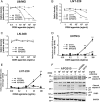APO010, a synthetic hexameric CD95 ligand, induces human glioma cell death in vitro and in vivo
- PMID: 21183510
- PMCID: PMC3064626
- DOI: 10.1093/neuonc/noq176
APO010, a synthetic hexameric CD95 ligand, induces human glioma cell death in vitro and in vivo
Abstract
Death receptor targeting has emerged as one of the promising novel approaches of cancer therapy. The activation of one such prototypic death receptor, CD95 (Fas/APO-1), has remained controversial because CD95 agonistic molecules have exhibited either too strong toxicity or too little activity. The natural CD95 ligand (CD95L) is a cytokine, which needs to trimerize to mediate a cell death signal. Mega-Fas-Ligand, now referred to as APO010, is a synthetic hexameric CD95 agonist that exhibits strong antitumor activity in various tumor models. Here, we studied the effects of APO010 in human glioma models in vitro and in vivo. Compared with a cross-linked soluble CD95L or a CD95-agonistic antibody, APO010 exhibited superior activity in glioma cell lines expressing CD95 and triggered caspase-dependent cell death. APO010 reduced glioma cell viability in synergy when combined with temozolomide. The locoregional administration of APO010 induced glioma cell death in vivo and prolonged the survival of tumor-bearing mice. A further exploration of APO010 as a novel antiglioma agent is warranted.
Figures





References
MeSH terms
Substances
LinkOut - more resources
Full Text Sources
Other Literature Sources
Medical
Research Materials
Miscellaneous

